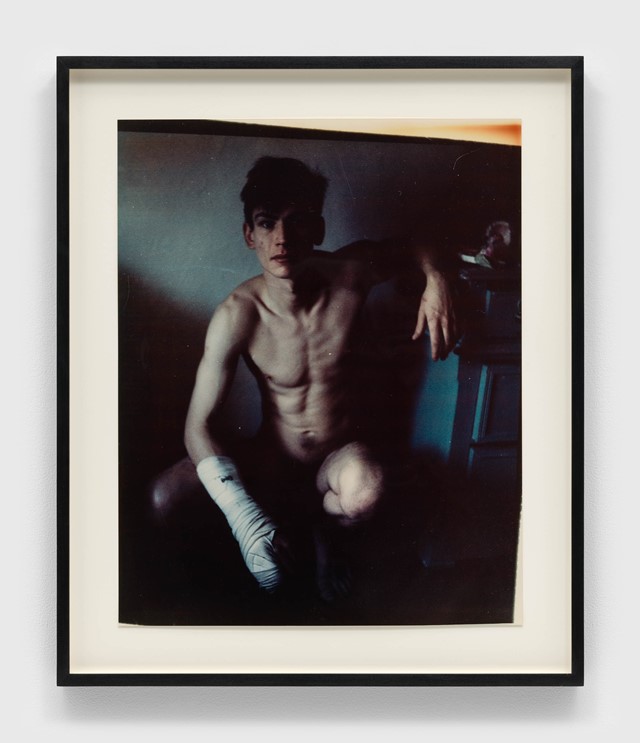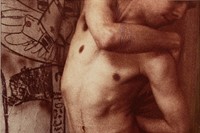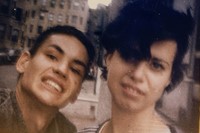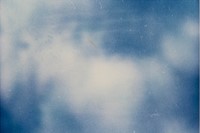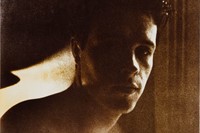As a new exhibition of Morrisroe’s work – organised by McGinley – goes on display in New York, the photographer tells AnOther why he’s compelled to introduce queer legacies to the next generation
The first Mark Morrisroe photograph that Ryan McGinley ever saw was Self-Portrait With Broken Finger from 1984. It was around the year 2000, just a few years after McGinley had moved from New Jersey to New York to photograph the city’s skateboarders, punks, and LGBTQ+ youth. This image, which introduced Morrisroe’s poetically tumultuous oeuvre, is among over 20 photographs currently on display at a new exhibition of the late photographer’s work at David Zwirner, organised by McGinley himself.
Much like every other work in the show, vulnerability and intimacy are inherent to this picture, which depicts a young Morrisroe naked but for a cast on his arm. His tired yet fiery expression recalls that of a boxer in the corner of a ring, while the intimate light illuminating one half of his face and body renders him an object of desire.
Part of David Zwirner’s exhibition series More Life, dedicated to the 40th anniversary of US Centers for Disease Control’s official recognition of Aids, the exhibition occupies the gallery’s characteristic uptown townhouse space where ornate decorative accents, including a fireplace, orchestrate an unexpected domestic backdrop for Morrisroe’s subversive work. A punk, sex worker, artist and maverick, Morrisroe photographed people around him in Boston, downtown New York and Jersey City, where he eventually died of Aids-related complications in 1989, aged just 30. Though cut short, his life and work radiate a sense of queer ecstasy – whether it’s photographs of nightclub performers, artist friends, Morrisroe himself, or more serene depictions of nature.
Here, Ryan McGinley opens up about the process of organising a Mark Morrisroe exhibition today and why he’s compelled to introduce queer legacies, especially those of artists, to the next generation.
“I never met Mark. He had already passed away by the time I’d moved to New York and begun taking photographs. When I was starting out, however, I was mentored by Jack Pierson, who was Mark’s long-term boyfriend in the 1970s and 80s. Through him, I became close friends with the Boston School crew, which, besides Mark and Jack, also included Nan Goldin, Philip-Lorca diCorcia, and Gail Thacker. Jack told me a lot about Mark’s character. He was believed to be the first punk in Boston, for example, and he went by the name Mark Dirt. He made zines in which he used this persona. He made a short film called Hello From Bertha in 1983, which was based on a Tennessee Williams play.
“He was shot once during sex work. He had an encounter with one of his johns, who shot him. The incident left [him with] a permanent limp and he lived with [this] disability for the rest of his life. Hardships always followed him. He grew up very poor and lived an impoverished life.
“Mark created a unique technique which he called ‘sandwiching’. After taking a colourful photograph of a subject, he would photograph its black and white negative and put the two images together. The dream-like, hazy effect of Mark’s images comes from this process.
“I love the cinematic quality of Mark’s work. Blood, sweat, and tears are all visible – and there is a romantic sensibility to it, too. I can picture him developing the prints in the dark room. The work is also personal for the very reason I particularly associate with artists who we lost to the Aids pandemic. When my brother died of Aids in 1995, he was an art student in the School of Visual Arts. He didn’t realise his dream, and so art about the Aids crisis is very personal for me. We need to continue the legacy and introduce the names to new generations, like I was while starting out.
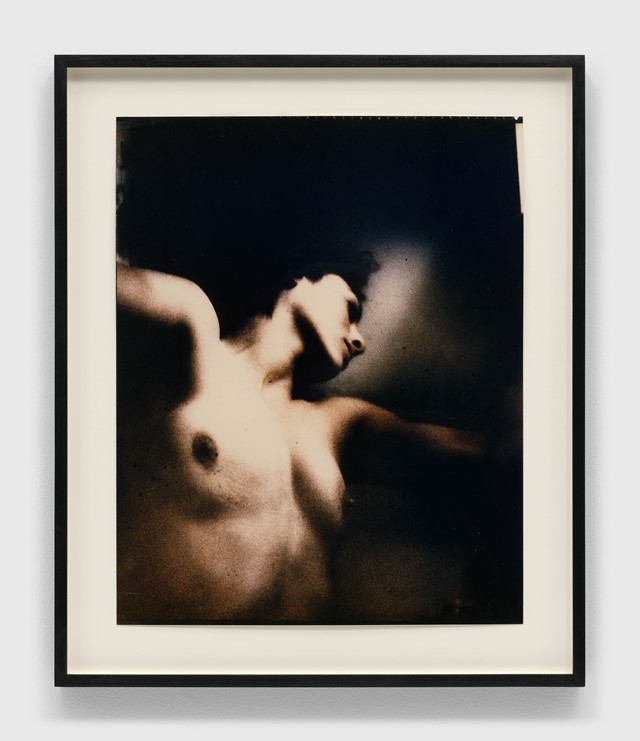
“Personal difficulties sometimes cause romanticisation of an artist’s life, especially queer artists who die at young age. People today attribute romanticism to Mark’s work because of his dreamy and sometimes abstract images. Artists who had similar lives, such as Arthur Rimbaud and Jean Genet, were influences on him, but his biggest inspiration was John Waters. Mark was obsessed with Waters and his book Shock Value: A Tasteful Book About Bad Taste, which at some point talks about a recipe of becoming a shocking artist. Mark took notes from it.
“When an artist dies, they gain a mythical persona. Mark’s peers who are now considered well-known names in fact reached that level of recognition after passing. Even Robert Mapplethorpe was very famous during his lifetime in a certain circle but fame mostly found him posthumously. Peter Hujar has only become what many would refer to as ‘a household name’ in the last ten years. Mark, I am sure, will soon develop that level of recognition as a photographer who invented a unique style and technique. This is especially urgent as we’ve reached the 40th anniversary of the discovery of HIV.
“Although I tried to pick mostly unseen images for this show, I thought it’s important to include iconic works, such as Self-Portrait With Broken Finger. I love Untitled (Malcolm) because it was the album cover of a Boston-based New Wave band’s record. Almost every photographer has that one image that ends up on an album cover – and I love that about music and photography. There are two photographs titled Sky. I hung them together because they in fact show the exact same image. They look uniquely different because of his sandwiching technique. There is an image of a very young Jack Pierson in which he looks like a baby when they were students and lovers. Untitled (Laurie) shows a woman in the water in Provincetown, Massachusetts, which has a history of being a getaway for the queer community. I vacation there like many other queer artists.
“If Mark was alive today, he’d probably also be a filmmaker. I can see his photographs eventually have some fashion angle, too. I can also predict he’d make music in a punk band at some point, probably during the 90’s grunge moment.”
More Life – Mark Morrisroe is at David Zwirner, 34 East 69th Street, New York until 3 August, 2021.
